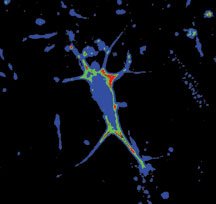 |
 |
|
 |
 |
 |
 |
 |
|
 |
 |
 |
 |

 |
 |
 |
 |

|
 |
Return to Table of Contents
Pollutant Mixes Can Affect
Nerve Cell Growth
Clam study may provide clues about human neurological mysteries
Carol Reinisch (profile), director of the MBL’s Laboratory of Aquatic Biomedicine, recently published the results of an EPA-funded clam embryo study that shows that, when combined, the pollutants bromoform, chloroform, and tetrachloroethylene can act synergistically to alter a key regulator in nerve cell development. While scientists have previously studied the effects of these pollutants individually, this is the first time anyone has demonstrated that the threesome can work together to adversely affect neuronally linked enzymes in a model organism.
 |
|
Clam neuron as seen with a confocal microscope
|
|
The study was published in the January 2005 issue of Environmental Toxicology and Pharmacology. It is the first step toward understanding how exposure to bromoform, chloroform, and tetrachloroethylene might affect human nerve cell development—knowledge that may one day provide clues about such neurological mysteries as autism spectrum disorder or attention deficit hyperactivity disorder.
Reinisch decided to study this particular chemical mixture after hearing news reports about Brick, New Jersey. Brick was at the center of a study by the U. S. Department of Health and Human Services’ Agency for Toxic Studies and Disease Registry (ATSDR) in 2000-01 that documented a higher than usual rate of autism spectrum disorder and explored its link to bromoform, chloroform, and tetrachloroethylene in the town’s water supply. Although the ATSDR study concluded that these chemicals posed no risk individually, Reinisch wondered about their combined effects. “My hypothesis was that these environmental chemical mixtures might induce alterations in neural development,” says Reinisch. She based her thinking on earlier work from her lab showing that PCBs specifically target neurons during embryogenesis.
To test her hypothesis, she and her colleagues treated developing surf clam embryos (Spisula solidissima) with different combinations of bromoform, chloroform, and tetrachloroethylene and studied their effects on stages of embryo development. “On a cellular level, clam neurons are extremely useful in studying basic mechanisms of development,” says Reinisch, an expert in PCB-induced neurotoxicity.
“Of the different combinations and strengths of bromoform, chloroform, and tetrachloroethylene components tested, we found that all three together induce the greatest adverse response. Treating the embryos with the triple mixture resulted in increased production of a subunit of an enzyme called protein kinase A (PKA), which previous research suggests plays a role in neural development,” says Reinisch. “Fluctuations in PKA may influence not only neuronal maturation, but also how neuronal networks are constructed during development,” she says. Alterations of this enzyme may affect neural plasticity and connections by activating or inactivating other proteins.
Demonstrating that clam embryos are affected by bromoform, chloroform, and tetrachloroethylene paves the way for additional studies that may help explain how exposure to the mixture affects fetal development. “We can clearly state that we found an increase in a component of PKA, and PKA is known to be involved in neural development. The chemical mixture is capable of altering neural development, and alterations in neural development are thought to be a cause of autism,” says Jill Kreiling, first author of the paper and a member of Reinisch’s lab. But Kreiling cautions, “We cannot say at this time if the alteration we see in clam embryos is the same alteration that causes autism. That will require future research.”
In fact, Reinisch and Kreiling have already begun the next phase of their work. They are currently examining the origins of bromoform, chloroform, and tetrachloroethylene toxicity at the single-neuron level to learn what genes are turned on and off by the exposure to the chemical mixture. The research is focused on a family of genes known as P53, which helps to regulate the cell cycle. They have also moved their studies to a new model system: the zebrafish, a vertebrate with more similarities to humans.
Carol Reinisch’s work on bromoform, chloroform, and tetrachloroethylene is funded by a STAR grant from the United States Environmental Protection Agency. Science supported by the STAR program is rigorously peer reviewed.
The full reference of the paper is:
Identification and phylogenetic comparison of p53 in two distinct mussel species (Mytilus). Muttray, AF, Cox, RL, St-Jean, S, van Poppelen, P, Reinisch, CL, Baldwin, SA. Comparative Biochemistry and Physiology Part C 140(2005) 237-250.
|
|
| |
 |
|
 |
 |
|